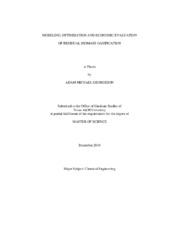Modeling, Optimization and Economic Evaluation of Residual Biomass Gasification
Abstract
Gasification is a thermo-chemical process which transforms biomass into valuable synthesis gas. Integrated with a biorefinery it can address the facility’s residue handling challenges and input demands. A number of feedstock, technology, oxidizer and product options are available for gasification along with combinations thereof.
The objective of this work is to create a systematic method for optimizing the design of a residual biomass gasification unit. In detail, this work involves development of an optimization superstructure, creation of a biorefining scenario, process simulation, equipment sizing & costing, economic evaluation and optimization. The superstructure accommodates different feedstocks, reactor technologies, syngas cleaning options and final processing options. The criterion for optimization is annual worth.
A biorefining scenario for the production of renewable diesel fuel from seed oil is developed; gasification receives the residues from this biorefinery. Availability of Soybeans, Jatropha, Chinese Tallow and woody biomass material is set by land use within a 50-mile radius. Four reactor technologies are considered, based on oxidizer type and operating pressure, along with three syngas cleaning methods and five processing options.
Results show that residual gasification is profitable for large-scale biorefineries with the proper configuration. Low-pressure air gasification with filters, water-gas shift and hydrogen separation is the most advantageous combination of technology and product with an annual worth of $9.1 MM and a return on investment of 10.7 percent. Low-pressure air gasification with filters and methanol synthesis is the second most advantageous combination with an annual worth of $9.0 MM.
Gasification is more economic for residue processing than combustion or disposal, and it competes well with natural gas-based methanol synthesis. However, it is less economic than steam-methane reforming of natural gas to hydrogen. Carbon dioxide credits contribute to profitability, affecting some configurations more than others. A carbon dioxide credit of $33/t makes the process competitive with conventional oil and gas development. Sensitivity analysis demonstrates a 10 percent change in hydrogen or electricity price results in a change to the optimal configuration of the unit. Accurate assessment of future commodity prices is critical to maximizing profitability.
Citation
Georgeson, Adam (2010). Modeling, Optimization and Economic Evaluation of Residual Biomass Gasification. Master's thesis, Texas A&M University. Available electronically from https : / /hdl .handle .net /1969 .1 /ETD -TAMU -2010 -12 -8733.


